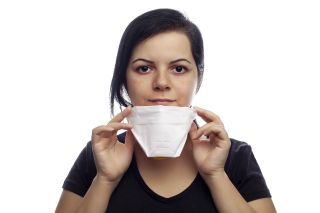Beauty
9 Scientific Explanations for Why Masks Enhance Our Beauty
Why do most people look better with masks on?
Posted March 19, 2023 Reviewed by Abigail Fagan
Key points
- Some people do not wear masks due to fears that masks detract from their attractiveness. Yet, according to studies, masks typically boost beauty.
- Potential mechanisms for this boost include the white-coat effect, regression to the mean, and the moderate-interpolation hypothesis.
- Researchers propose that aside from using masks for public health purposes, masks might be used to “level the playing field” of attractiveness.

As the pandemic rages on, masking mandates in the United States have loosened dramatically. Many Americans no longer wear masks, citing reasons such as inconvenience, discomfort, and cost.
A recent study by Cha et al. (2023) presented another reason — the belief that masks reduce one’s physical attractiveness. In this study, people who rated themselves as better looking were less willing to wear a mask. This was explained by the belief that masks might lower their attractiveness. In addition, this association was stronger in situations where participants needed to make a good impression (i.e., interviewing for a job vs. walking a dog). The researchers concluded that masks may now serve as a “self-presentational” technique in addition to a health behavior.
Indeed, research has supported that masking can change perceptions of people, but mostly for the better. Masking has typically been linked to boosts in beauty. But why does this occur? Researchers have identified nine possible psychological reasons:
1. Reversal of the Sanitary-Mask Effect: Masks now make us seem healthier and more socially responsible.
Researchers collected Japanese participants’ ratings of masked and unmasked faces before and during the COVID-19 pandemic, finding that prior to the pandemic, masks decreased the attractiveness of faces. However, during the pandemic, masks instead increased physical attractiveness, along with perceptions of physical health. Researchers propose that prior to the pandemic, masking was associated with poor personal health, thus decreasing views of attractiveness (the “sanitary-mask effect”), whereas during the pandemic, as masking became the norm, the association reversed. Masking is now associated with both greater health and concern for others, thus increasing attractiveness.
2. The White-Coat Effect: Masks make others associate us with admirable medical professionals.
In another study, 43 female psychology undergraduates in the UK rated the attractiveness of male faces that were either uncovered or partially covered below the eyes using a medical mask, a cloth mask, or a book. While both cloth and medical masks boosted attractiveness ratings, medical masks were especially impactful. Therefore, the researchers concluded that the “white-coat effect” was at play. That is, participants perhaps associated medical masks with medical professionals, perceiving men wearing medical masks as more “responsible, “caring”, or “trustworthy”. In this study, the baseline attractiveness of male faces did not affect results.
3. Regression to the Mean: Masks make everyone look more average.
In another study of 207 MTurkers, participants rated the attractiveness of masked and unmasked faces. Results indicated that across all the faces, masks did not affect attractiveness. That is, the average attractiveness of masked faces was similar to the average attractiveness of unmasked faces. However, “regression to the mean” was demonstrated in that people were rated as more average with masks on. In other words, unattractive faces were rated as more attractive, and attractive faces were rated as less attractive. The authors concluded that masks could “level the playing field”.
4. Obscuring Sexual Dimorphism: Masks make it harder to assess sexual dimorphism, especially in women.
In the above study, the authors further found that masking effects were stronger for the least and most attractive female faces than for the corresponding male faces. To explain these findings, the researchers emphasize the role of the lower face in assessing youth and sexual dimorphism, particularly for women. They write that in women, “a squared-off jaw contributes to perceived aging, more masculinity, and less attractiveness—whereas traits such as eye size and depth, eyebrow thickness, and hairline are more important to male faces” (p. 8). However, other research indicates that facial measurements involving the lower face play a role in men’s attractiveness.
5. The Occlusion Effect: Masks hide unattractive features.
One of the most obvious mechanisms for enhanced beauty is the occlusion effect, or the effect of covering up unattractive features. Consistent with the occlusion effect, the benefits of masking on attractiveness can depend on one’s pre-existing attractiveness. Nearly 500 MTurkers rated the attractiveness of 60 masked or unmasked faces of varying attractiveness. Results indicated that 100% of the unattractive faces were rated as better looking with a mask on, with an average attractiveness increase of 42% for both men and women. In contrast, approximately 75% of average faces were more attractive with a mask on, with an average increase of 19% for women and 24% for men. For attractive faces, while most did not experience a significant change in attractiveness, those that did actually decreased. Thirteen percent of women were less attractive with a mask on compared to 20% of men. The average boost in attractiveness of faces was still positive, at 6% for women and 8% for men. The researchers conclude that masks hide our ability to assess important aspects of beauty, such as symmetry, averageness, and facial harmony.

6. Positivity Bias: We fill in the blanks of the face with positive information.
Another study similarly supported the Occlusion effect, and offered a theory to explain the results. The researchers found that based on ratings of 181 MTurkers, masking increased the attractiveness of both young and old faces if they were unattractive, but did not affect the attractiveness of good-looking faces. This finding held when faces were cropped rather than masked. To explain these results, researchers proposed a “positivity bias”, where missing information (i.e., the lower half of the face) is assumed to be positive. Indeed, humans (at least in the United States) tend to be overly optimistic.
7. Gestalt Theory: We replace missing information about faces with an idealized image.
Another study of Chinese participants reached a similar conclusion as above but framed their findings with a different theory. In two experiments involving 440 Chinese participants, face masks enhanced the appearance of average looking employees, thus leading to greater customer satisfaction. However, face masks did not affect the attractiveness of good-looking male employees, and in fact, lowered the attractiveness of good-looking female employees (and thus ratings of customer satisfaction). The researchers explain that based on Gestalt theory, people may be automatically filling in missing information about others’ faces with an ideal image. Yet, this would not explain why good-looking women were perceived as less attractive. Perhaps rather than filling in the blanks with ideal information, people may fill them in with average information.
8. The Moderate Interpolation Hypothesis: We make templates of moderate attractiveness for faces that we often see in real life.
With the above question in mind, researchers sought to test the moderate interpolation hypothesis, or the idea that rather than filling in the blanks of a face with a positive or ideal image, people may see the rest of the face as moderate in attractiveness. To test this question, 156 Japanese students rated images of own-ethnicity and other-ethnicity (White, Black, non-Japanese Asian) faces that were masked or unmasked. The researchers believed that own-ethnicity faces would be rated as similarly attractive with or without a mask, due to a fairly accurate “template” of moderate attractiveness that participants built through extensive real-life interactions with own-ethnicity individuals. However, due to lack of real-life exposure to faces of other ethnicities, the template for other ethnicities would be overly positive, resulting in a boost for masked faces. For example, templates for other ethnicities might be based on faces seen in the media, like of actors and celebrities. Indeed, the researchers found a different effect for own-ethnicity vs. other-ethnicity faces. Specifically, own-ethnicity faces were less attractive when masked, whereas other-ethnicity faces were more attractive when masked.
9. Wrinkle Removal: Masks make us look less wrinkly.
In another U.S. study, researchers took images of 100 plastic surgery patients masked and unmasked. Images were then rated by six judges. Results indicated that masking decreased perceptions of age by 6% (about three years) and wrinkles by 10%. However, younger patients (18-40 years old) did not appear younger in a mask. The researchers did not offer an explanation for the effect of age, however, it is possible that when we are relatively young, indicators of aging on the lower face are more subtle. The researchers also point out that “vertical lip rhytids, nasolabial folds, and jowls” (p. 6), all located on the lower face, are important in judgements of age.
Although these studies identified different potential mechanisms for the beauty-enhancing effects of masks, the message is clear. At this time, masks rarely decrease attractiveness, except in the case of very attractive faces (or in Japan, same-ethnicity faces). Perhaps participants in Cha et al.’s study were right to fear that their good looks would be dampened — that is, if their self-ratings were based in truth. Furthermore, masking seems to be associated with good inner qualities, such as concern for others. Given that the pandemic is continuing, perhaps informing people of these positive effects will help to encourage the positive health behavior of masking.
In addition, as several of the researchers concluded, aside from using masks for public health purposes, masks might be used as a positive way to “level the playing field” in employment settings.
However, social norms quickly change. Based on previous research, associations with masks can fluctuate based on time and culture. Now that mask mandates are no longer the norm (at least in the U.S.), how will maskers be perceived? Will they retain an overall boost to their inner and outer beauty, or will the “sanitary-mask effect” prevail?




